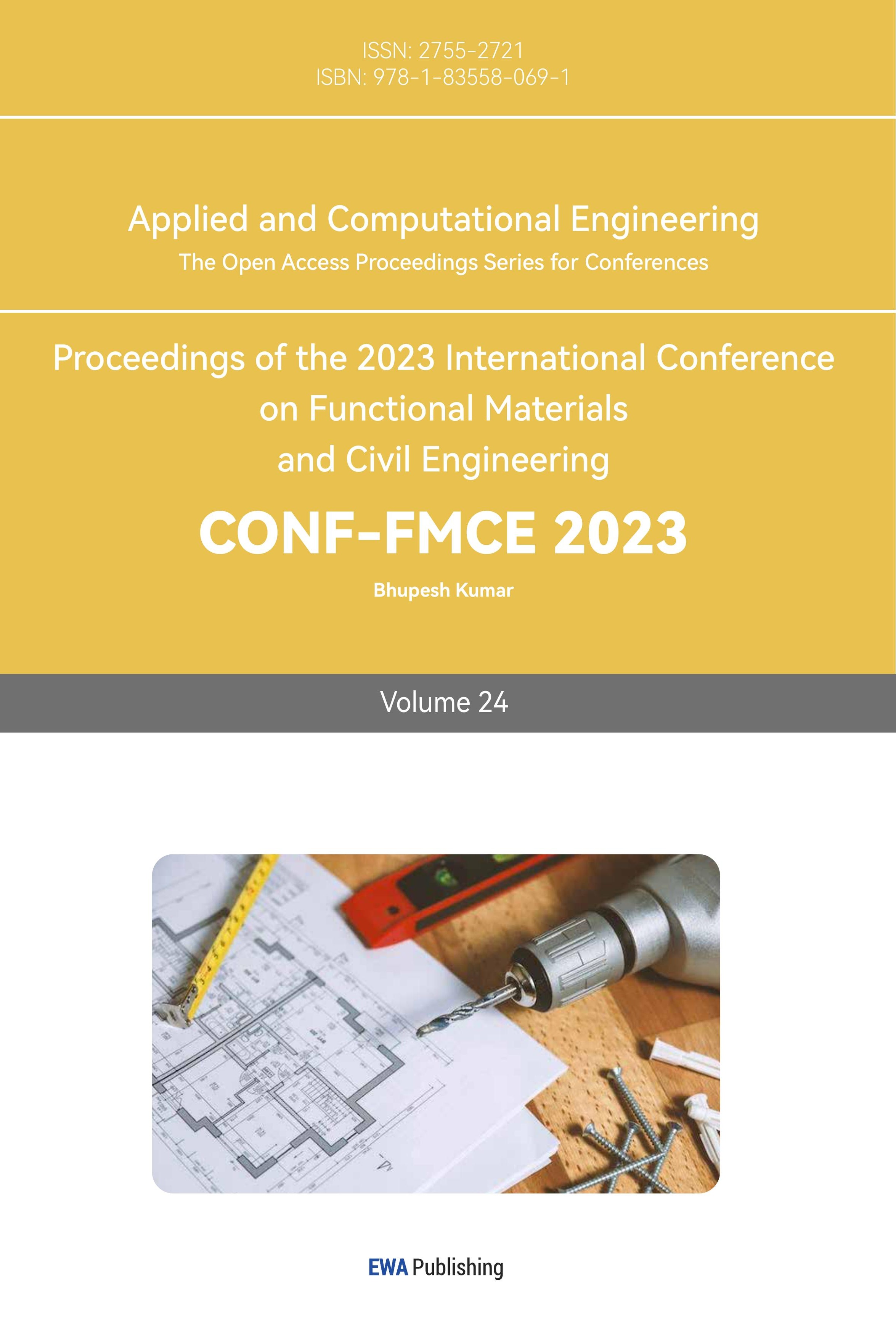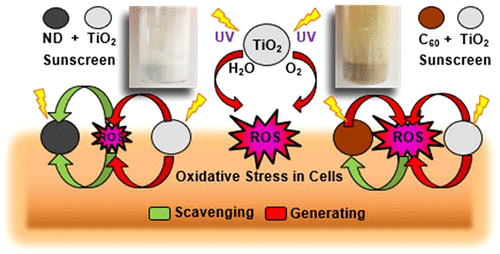1. Introduction
The cosmetic industry has been increasingly incorporating nanomaterials, particularly in sunscreen which has been a topic of great interest in recent years [1]. They offer several advantages over traditional sunscreen ingredients, such as improved transparency, water resistance, and better protection against both UVA and UVB radiation. However, there are rising worries about the possible threats that these nanoparticles may pose to human health and the environment, particularly because of the increased absorption of nanoparticles through the skin.
Sunscreen is a necessary cosmetic product that protects the skin from the damaging effects of the sun's UV radiation. Sunscreens are classified into two types: chemical and physical. As demonstrated in Figure 1, chemical sunscreens absorb UV light whereas physical sunscreens reflect it. Even though chemical sunscreen has advantages such as being lighter, non-sticky, and easy to penetrate skin due to the fact it uses chemical actives which are usually organic and carbon-based compounds, it has a number of inconveniences such as the waiting time of 30min to be effective and its non-suitability for eczema, rosacea and other sensitive skin. On the contrary, physical sunscreens are proven to be more effective than chemical sunscreens as they provide broad-spectrum UVA and UVB radiation protection. They also work instantly and are suitable for much sensitive skin as they usually include natural minerals like titanium dioxide and zinc oxide. Their mechanism is to create a barrier of protection over the skin which reflects all UV rays away just like a shield. Therefore, in recent years, physical sunscreens have gained popularity due to their effectiveness and safety profile.
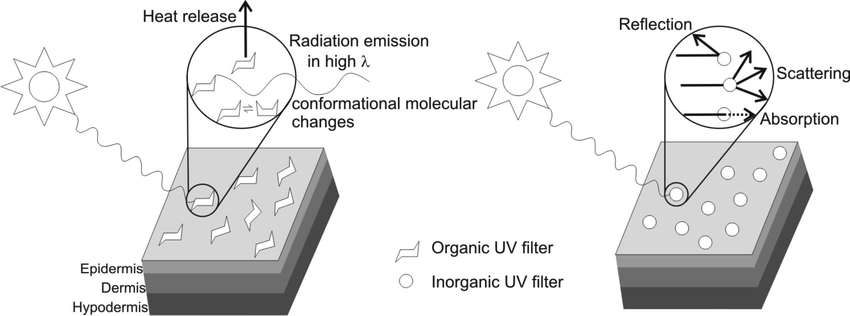
Figure 1. Inorganic and organic UV filters [2].
Nevertheless, there is still space for them to be improved and one of the challenges of physical sunscreens has been their tendency to leave a white residue on the skin which also makes them hard to blend. It is due to how it works by creating a barrier sitting on the surface of your skin and reflecting the sun rays. However, advances in technology have allowed the production of titanium dioxide with zinc oxide particles in nano size that are virtually invisible on the skin. These nanoparticles provide better coverage and enhance the effectiveness of physical sunscreens.
There are several types of nanoparticles that are commonly used in sunscreen formulations. The two most popular forms are titanium dioxide (TiO2) and zinc oxide (ZnO), which are employed as UV filters in sunscreens because of their propensity to reflect and scatter UV rays.
These photoactive nanoparticles are confined into carriers that isolate them cf. Figure 2. These are the encapsulation techniques that have been developed to prevent the release of nanoparticles from sunscreen. The process involves the use of a protective layer around the nanoparticles to ensure their stability and safety. It also helps to improve the effectiveness of sunscreen products because there is no direct interaction between UV active and skin components. It also minimizes the possibility of toxicological risks and ultimately reduces photodegradation. The success and performance of the encapsulated UV absorber will be influenced by the structure of the arrangement, such as whether it has a core or a matrix structure [3].
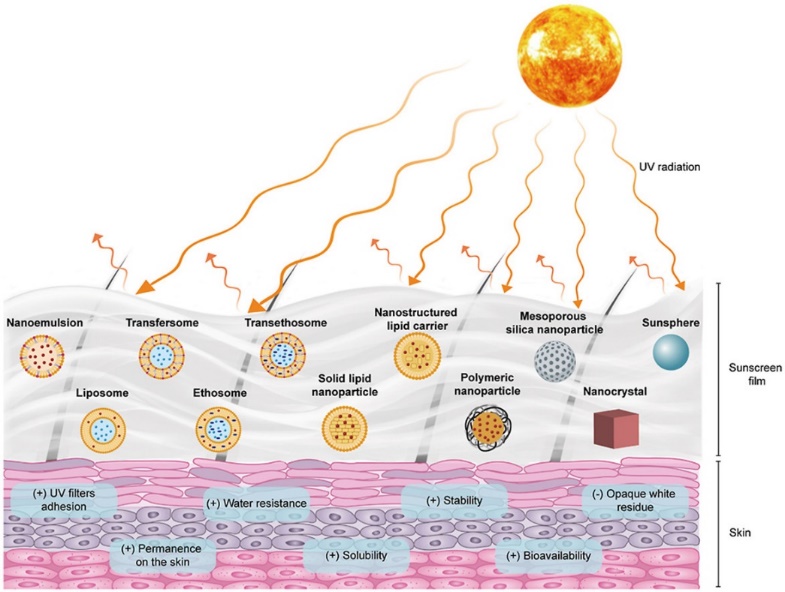
Figure 2. different types of nanocarriers used as UV filters [4].
Nevertheless, the problem is that the use of nanomaterials in cosmetics, particularly in sunscreens, is a relatively new field. Their potential risks and benefits are not yet fully understood. There is a need to explore and investigate more on the present level of knowledge regarding the incorporation of nanoparticles into sunscreen cosmetics and to critically evaluate the risks and benefits associated with their use. In fact, it is worth noting that UV filters are rapidly being included in a wide range of common items other than just sunscreen such as creams, lipsticks, foundations or powders. Therefore, researches are important as they address the potential risks associated with nanomaterials in sunscreens and evaluates the effectiveness of safety measures used to limit these risks.
This article will begin by reviewing the current literature on the use of nanomaterials in sunscreens and UV filters and critically evaluate the risks and benefits associated with their use. Then, based on the review and assessment findings, it will p provide regulations of various countries regarding the application of nanoparticles in UV-protective cosmetics. In addition, this article also includes a critical analysis and discussion of the risks and benefits of using nanoparticles, with a focus on TiO2 NPs and ZnO NPs in sunscreens and UV filter cosmetics, which show promising properties.
Overall, the purpose of this research is to offer a complete review of the present state of knowledge on the use of nanomaterials in cosmetics, with an emphasis on sunscreens products, by comparing and assessing TiO2 and ZnO NPs in sunscreen formulations from multiple perspectives. This review's findings are likely to lead to a better understanding of their safety and effectiveness, as well as provide insight into present measures.
2. The use of TiO2 in sunscreen
Titanium dioxide is the most commonly used nano UV filter in sunscreen. Its original form is a white-coloured odorless powder that is insoluble in water and UVA and UVB rays can be reflected and scattered effectively. In sunscreen formulations, it is typically used as a physical sunscreen. Nanosized titanium dioxide particles (TiO2 NPs) usually have a smaller size compared to regular titanium dioxide particles and this will allow them to provide a broader UV spectrum protection thus a better coverage and a more invisible appearance on the skin. Figure 3 clearly shows that the smaller the nano titanium oxide particles are, the better they could attenuate UV radiations [5].
When applied to the skin, titanium dioxide nanoparticles create a thin and transparent film that reflects and scatters UV radiation. This helps to prevent UV radiation from penetrating the skin and avoid damage from sun exposure such as sunburn and premature aging of the skin. It is also generally considered to be safe and well-tolerated by most individuals. It is also a very stable particle that does not break down when exposed to sunlight or heat. All this makes it one of the most effective and reliable UV filters.
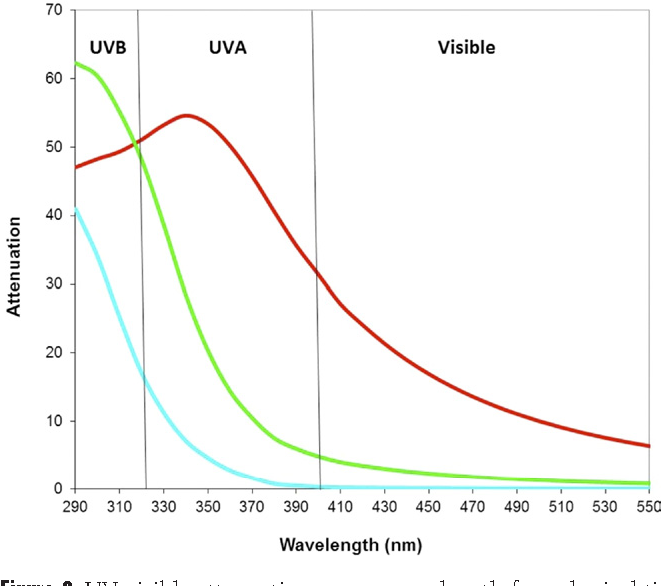
Figure 3. UV-visible attenuation versus wavelength for spherical titanium dioxide of varying particle. size. Blue line, 20 nm; green line, 50 nm; and red line, 100 nm [5].
3. The use of ZnO in sunscreen
Zinc oxide is another commonly used active ingredient in many physical sunscreens. It is also used as a broad-spectrum UV filter that protects against both UVA and UVB rays. Zinc oxide, like titanium dioxide, works by reflecting and scattering UV radiation as well, rather than absorbing it like some other sunscreen ingredients such as for chemical sunscreens.
In sunscreen formulations, zinc oxide is frequently utilised as tiny particles with size fewer than 100 nanometers. Again, it provides better protection against UV radiation than larger particles of zinc oxide just like titanium dioxide. When applied to the skin, zinc oxide nanoparticles also create a thin, transparent film that helps to protect the skin from UV radiation. Zinc oxide is also a popular choice in sunscreens because it is gentle on the skin and suitable for even those with eczema and sensitive skin. It is considered to be less irritating than some other sunscreen ingredients.
In addition to its UV protection capabilities, zinc oxide provides certain additional skin advantages. For instance, it contains anti-inflammatory effects that can help reduce redness and inflammation while also soothing the skin as well as limiting the emergence of wrinkles and other signs of ageing.
4. The comparisons
Nanoparticles are typically used in sunscreen formulations because they provide better UV protection and a more pleasant texture compared to larger particles. When applied to the skin, nanoparticles create a thin, transparent film that offers broad-spectrum defence against UVA and UVB radiation. To create nanoparticles, the larger titanium dioxide and zinc oxide particles are broken down into smaller particles using various techniques such as milling or high-pressure homogenization.
This process creates particles that are typically 10-100 nanometers in size. The most used nanomaterials in sunscreens are TiO2 NPs and ZnO NPs. In addition to them, other types of nanoparticles such as iron oxide, cerium oxide, tungsten oxide, and silicon oxide are also used in some sunscreen formulations. These particles may provide additional benefits such as antioxidant activity or a better cosmetic appearance on the skin. However, titanium dioxide and zinc oxide continue to be the most well-known and widely utilised among all of them as they present some really promising characteristics and specific functions.
In fact, both TiO2 and ZnO nanoparticles are metal oxides widely utilized in sunscreens.
TiO2 and ZnO nanoparticles have different crystal structures and compositions and these give them different unique properties. This discussion aims to compare and contrast the efficacy, safety, and environmental considerations associated with the incorporation of TiO2 and ZnO NPs into cosmetics, notably sunscreens.
There are numerous advantages of employing nanoparticles in physical sunscreens. They both improve the cosmetic appearance of the product, enhance its effectiveness, and reduce the need for reapplication. They are also smoother and easier to apply on the skin with increased sun protection and broader spectrum protection, enhanced stability, lower concentration needed, even lower toxicity, and potent antioxidant and anti-inflammatory properties.
For TiO2, it provides improved transparency with their smaller particle size which allows for better dispersion, thus significantly reducing the whitening cast that can occur with larger TiO2 particles. This can lead to sunscreens that are more cosmetically acceptable and easier or smoother to apply such as foundations and creams. They also have increased sun protection thanks to the higher ratio of their surface area to their volume. This is due to the particles' ability to absorb and scatter more UV light than bigger particles, resulting in broader UV spectrum protection. They also have enhanced stability as they have a greater resistance to photodegradation and photoactivity which helps them to improve the stability of sunscreens over time. This can also ensure that the sunscreen maintains its effectiveness throughout the time. Finally, they also only need a lower concentration of nano-sized TiO2 particles may be needed in sunscreens than particles with larger sizes. This can result in a reduction in the overall concentration of active ingredients in the sunscreen which can be beneficial for individuals with sensitive skin but also a huge asset for the manufacturers in terms of cost and waste.
For ZnO, it also has the advantages of TiO2 listed below such as broad-spectrum protection against both UVA and UVB radiation, increased stability than larger particles, improved transparency reduction of white cast and lower toxicity because of their smaller particles which are less likely to penetrate the skin thus reducing the risk of skin irritation.
Apart from that, it also has some potential additional benefits. In fact, some research suggests that nano ZnO particles may be antioxidant and anti-inflammatory. This could prevent damage caused by UV radiation even better than TiO2.
One of the key differences between TiO2 and ZnO nanoparticles is their ability to absorb UV radiation. In fact, even though they both offer effective UV protection, their performance may however differ in terms of wavelength coverage and photostability. TiO2 nanoparticles primarily absorb UVB radiation, while ZnO nanoparticles provide broad-spectrum protection by absorbing both UVA and UVB radiation [6]. In fact, their unique electronic band structure allows them to absorb a wide range of UV wavelengths, making them ideal for comprehensive photoprotection [7].
This indicates that ZnO nanoparticles have a broader spectrum of protection compared to TiO2 nanoparticles and it also has the broadest spectrum in all the sunscreen ingredients approved by FDA (Table 1) [8]. Additionally, studies have shown that ZnO nanoparticles exhibit superior photostability compared to TiO2 nanoparticles, ensuring prolonged and consistent UV protection [6]. Nevertheless, TiO2 nanoparticles, especially when modified with coatings, have also shown improved photo-stability, ensuring prolonged protection against UV radiation.
Both TiO2 and ZnO nanoparticles are incorporated into sunscreen formulations as dispersions or nanoscale powders. These nanoparticles are typically dispersed in a suitable carrier medium, such as creams, lotions, or sprays, to facilitate their application on the skin.
Table 1. A comparative analysis of the available UV filters available in the United States as well as their range of UV protection. Protection level: :extensive, : considerable, :limited, :minimal [8].
FDA Monograph Sunscreen Ingredients | Amount of Ray Protection | Chemical (C) or Physical (P) | |
UVA | UVB | ||
Aminobenzoic acid (PABA) |
| C | |
Avobenzone | C | ||
Cinoxate | C | ||
Dioxybenzone | C | ||
Ecamsule | C | ||
Homosalate | C | ||
Menthyl anthranilate | C | ||
Octocrylene | C | ||
Octyl methoxycinnamate | C | ||
Octyl salicylate | C | ||
Oxybenzone | C | ||
Padimate O | C | ||
Phenylbenzimidazole | C | ||
Sulisobenzone | C | ||
Titanium dioxide | P | ||
Trolamine salicylate | C | ||
Zinc oxide | P | ||
However, even though the advantages of TiO2 and ZnO are very significant, concerns have been raised about the potential risks associated with the use of nanomaterials in sunscreens.
Despite the fact that TiO2 and ZnO offer substantial benefits, there are still concerns regarding the possible threats created by the usage of nanoparticles in sunscreens. That is why it is important to ensure that these particles are used responsibly and that their potential risks are thoroughly evaluated and acknowledged by customers.
One of them is the potential for skin penetration, inhalation, allergic reactions and toxicity which may lead to harmful health impacts. Studies have shown that nanoparticles can penetrate the epidermis and potentially enter the bloodstream. They could also potentially accumulate in organs and produce reactive oxygen species (ROS) from metal oxide nanoparticles when exposed to UV radiation which are potentially cytotoxic and carcinogenic and could lead to DNA damage and inflammation and eventually create cancer and infertility after some studies. This whole process can be seen in Figure 4 shown below which clearly shows each step of the formation of ROS. This can be particularly problematic for people with weak skin barriers [9]. Nevertheless, the existing literature suggests that the risks associated with skin penetration are minimal, especially when compared to the benefits of using sunscreens.
Figure 4. ROS formation process from TiO2 reactions [9].
Another important factor to consider when comparing TiO2 and ZnO nanoparticles is their safety in sunscreen formulations. In fact, the safety of TiO2 and ZnO nanoparticles in cosmetics has been extensively studied. Even though both nanoparticles have been considered safe for topical application in sunscreen products, concerns have been still raised regarding their potential toxicity and to penetrate the skin and then enter the body through blood steam [10]. TiO2 nanoparticles are known to be less stable than ZnO nanoparticles and it can lead to a potential decrease in their effectiveness over time. On the other hand, ZnO nanoparticles are highly stable in sunscreen formulations which ensures their long-term effectiveness in providing sun protection. Studies have also shown that ZnO nanoparticles have a lower potential to penetrate the skin compared to TiO2 nanoparticles, making them a safer option [11]. Nonetheless, comprehensive toxicological studies are necessary to ensure their long-term safety.
While TiO2 and ZnO nanoparticles have shown potential benefits in sunscreens, their potential environmental impact has been a subject of concern and has also been investigated. Some studies suggest that these nanoparticles can enter aquatic ecosystems, potentially impacting aquatic organisms [12].
In fact, it shows that nanoparticles can accumulate in water (Figure 5) especially during showering and swimming, potentially harming aquatic organisms and damaging the ocean (e.g., coral reefs, sea urchin embryos, marine worms, fish, mussels or even crustaceans and algae) [13]. While both TiO2 and ZnO nanoparticles have low toxicity to aquatic organisms, their release into aquatic ecosystems can pose risks. TiO2 nanoparticles have been found to accumulate in aquatic environments, potentially affecting the growth and development of aquatic organisms [14]. Similarly, ZnO nanoparticles have been shown to exhibit toxic effects on certain organisms at higher concentrations [15]. Proper disposal methods and wastewater treatment processes should be considered to minimize potential environmental harm.
However, the concentration of nanoparticles in sunscreens is relatively low, so the environmental impact is likely to be minimal. Furthermore, many sunscreens now use biodegradable nanoparticles that are less likely to cause environmental issues. Overall, comprehensive studies are still needed to fully understand the extent of their environmental and health effects.
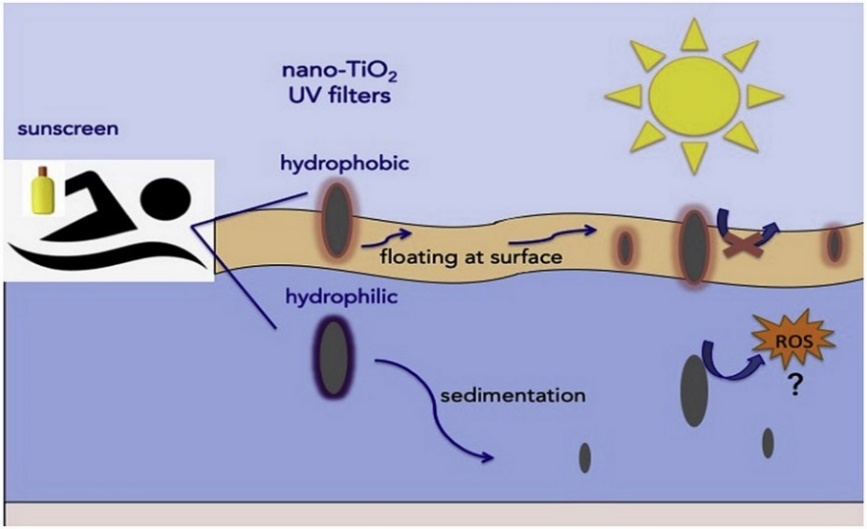
Figure 5. Potential environmental risks of nano sunscreens in the ocean [13].
Nonetheless, many countries have established specific regulations for the use of nanomaterials in sunscreen and all other products containing UV filters. These can be varied depending on the country. The European Chemicals Agency (ECHA) has a number of regulations about the use of nanoparticles in sunscreen in European Union countries. The ECHA has specific requirements for nano sunscreens. For example, a maximum concentration for TiO2 and ZnO of 25%, prohibition to be used on the lips when combine with Alumina and Manganese Dioxide, no powders or sprayable products and nanoparticles need to be appropriately coated [16, 17]. In the United States, the Food and Drug Administration (FDA) has more severe rules about nano sunscreens. In fact, more than seven criteria have been included for regulating the use of nanoparticles in sunscreen products ranging from maximum SPFs to the safety status of active ingredients, followed by broad-spectrum requirements, dosage forms, labelling, final formulation testing and recordkeeping [18]. However, it is worth noticing that nano TiO2 and ZnO are the only 2 sunscreen ingredients that have GRASE (generally recognised as safe and effective) status and ZnO would have been the best UV ray protection among all ingredients according to FDA [8, 18].
Overall, while both TiO2 and ZnO nanoparticles are effective in providing sun protection, ZnO nanoparticles are considered to be a more reliable and safer option due to their ability to absorb both UVA and UVB radiation, high stability in sunscreen formulations, and lower potential to penetrate the skin.
However, ongoing challenges and prospects still surround their application in this field. One of the key challenges is the potential health and safety risks associated with the use of nanomaterials in sunscreens which necessitates extensive research to ensure consumer safety. To mitigate the potential negative impacts of TiO2 and ZnO on both human health and the environment, researchers are currently investigating ways to change their surface properties and particle size. Moreover, there is also a lack of consistent regulatory frameworks for nanomaterials used in sunscreens. As different countries have different regulations, it makes this very challenging for companies to navigate the global market. At this point, developing standardized regulations that address safety, labeling, and manufacturing practices is crucial for the development of the nano sunscreen market.
Furthermore, the advancement of nanocoatings and encapsulating techniques may offer promise for improving the durability and efficacy of these nanoparticles in sunscreens. These developments allow the release of active ingredients in a controlled manner which opens up further possibilities for the targeted delivery of sunscreens, allowing for longer-lasting and more effective protection against UV radiation. On top of that, nanomaterials such as TiO2 and ZnO actually have the potential to go beyond UV protection. In fact, researchers are exploring their use in other areas such as antioxidant properties, anti-aging effects, and even self-healing properties for damaged skin. These multifunctional applications could revolutionize the field of sunscreens and cosmetics. That is why continuous research and innovation are required to address these issues and realise the full potential of TiO2 and ZnO.
To summarize, the existing literature suggests that the use of nanomaterials in physical sunscreens has revolutionized the industry and proved significant benefits. Despite the possibility of hazards, they pale into insignificance compared to the advantages of exploiting them. Furthermore, many of these risks can be limited when proper safety measures are taken, such as particle size and concentration controls.
5. Conclusion
In conclusion, the use of nanotechnology in the cosmetic industry especially in sunscreens offers several advantages including improved transparency with a reduced white cast, smoother to apply on skin, enhanced stability, lower toxicity, and better protection against UV radiation. However, the potential risks associated with their enhanced absorption should not be overlooked. Some research has previously demonstrated that nanoparticles may possibly pass through the skin, accumulate in organs, and produce oxidative stress, which can lead to DNA damage and cancer. Additionally, the potential environmental risks of nanoparticle exposure through sunscreens have also been a concern.
That is why the use of nanotechnology in the cosmetic industry, particularly in sunscreens still requires ongoing evaluation with more diverse methods and precisions. Future research should not only focus on improving the understanding of the mechanisms of the potential risks and benefits of nanomaterials in sunscreens but also on further formulation challenges of nano UV filters incorporated in other cosmetic products.
Overall, while the use of nanomaterials in sunscreens provides significant benefits, it is important for people to balance these benefits with potential risks. Commercials and governments also need to take appropriate measures or even refine them and precautions to ensure the safety of consumers and the environment.
References
[1]. Salvioni, L., Morelli, L., Ochoa, E., Labra, M., Fiandra, L., Palugan, L., ... & Colombo, M. 2021 Advances in Colloid and Interface Science, 293, 102437.
[2]. Berbel Manaia, E., Kaminski, R., Corrêa, M., Chiavacci, L. 2013 Brazilian Journal of Pharmaceutical Sciences. 49. 201-209.
[3]. Damiani, E., & Puglia, C. 2019 Nanocarriers and microcarriers for enhancing the UV protection of sunscreens: An overview. Journal of Pharmaceutical Sciences, 108(12), 3769-3780.
[4]. Santos, A. C., Marto, J., Cha-Cha, R., Martins, A. M., Pereira-Silva, M., Ribeiro, H. M., & Veiga, F. 2022 Materials Today Chemistry, 23 100709.
[5]. Wang, S. Q., & Tooley, I. R. 2011 Seminars in cutaneous medicine and surgery 30 210-213.
[6]. Gulson, B., McCall, M. J., Korsch, M. J., Gomez, L., Casey, P., Oytam, Y., ... & Taylor, A. 2010 Toxicological Sciences, 118 140-149.
[7]. Ben Elkamel, I., Hamdaoui, N., Mezni, A., Ajjel, R., & Beji, L. 2019 Journal of Materials Science: Materials in Electronics, 30 9444-9454.
[8]. Siller, Alfredo & Blaszak, Scott & Lazar, Michelle & Harken. 2018 Plastic Surgical Nursing. 38. 158-161.
[9]. Lin, Q., Xu Xu, R. H. J., Yang, N., Karim, A. A., Loh, X. J., & Zhang, K. 2019 ACS Applied Nano Materials, 2 7604-7616.
[10]. Petersen E.J., Diamond S.A., Kennedy A.J., Goss G. G., Ho K., Lead J., Hanna S.K., Hartmann N.B., Hund-Rinke K., Mader B., Manier N., Pandard P., Salinas E.R., and Sayre P. 2015 Environmental Science & Technology 49 9532-9547,
[11]. Gulson, B., McCall, M. J., Bowman, D. M., & Pinheiro, T. 2015 Archives of toxicology, 89 1909-1930.
[12]. Petersen, E. J., Diamond, S. A., Kennedy, A. J., Goss, G. G., Ho, K., Lead, J. R., ... & Hanna, S. K. 2015 Environmental Science: Nano, 2 549-561.
[13]. Slomberg, D. L., Catalano, R., Bartolomei, V., & Labille, J. 2021 Environmental Pollution, 271 116263.
[14]. Li, M., Luo, Z., Yan, Y., Wang, Z., Chi, Q., Yan, C., & Xing, B. 2016 Environmental Science & Technology, 50 9636-9643.
[15]. Miao, A. J., Zhang, X. Y., Luo, Z., Chen, C. S., Chin, W. C., Santschi, P. H., & Quigg, A. 2010 Environmental Toxicology and Chemistry, 29 2814-2822.
[16]. Regulations of the European Commission on sunscreen products. Available from : https://single-market-economy.ec.europa.eu/sectors/cosmetics/cosmetic-products-specific-topics/sunscreen-products_en [accessed 22 Apr, 2023]
[17]. Fact sheet entitled Sunscreens with titanium dioxide as nanoparticles Health risks? Based on the opinion of the independent Scientific Committee on Consumer Safety (SCCS): ‘Opinion on titanium dioxide (nano form) COLIPA n° S75’ (April 2014). Available from: https://ec.europa.eu/health/scientific_committees/docs/citizens_titaniumnano_en.pdf [accessed 22 Apr, 2023]
[18]. Interview of Theresa M. Michele, M.D (16/12/2022). An update on sunscreen requirements: The deemed final order and the proposed order. Available from: https://www.fda.gov/drugs/news-events-human-drugs/update-sunscreen-requirements-deemed-final-order-and-proposed-order [accessed 22 Apr, 2023]
Cite this article
Wang,X. (2023). The Comparison of Titanium Dioxide and Zinc Oxide Used in Sunscreen Based on Their Enhanced Absorption. Applied and Computational Engineering,24,237-245.
Data availability
The datasets used and/or analyzed during the current study will be available from the authors upon reasonable request.
Disclaimer/Publisher's Note
The statements, opinions and data contained in all publications are solely those of the individual author(s) and contributor(s) and not of EWA Publishing and/or the editor(s). EWA Publishing and/or the editor(s) disclaim responsibility for any injury to people or property resulting from any ideas, methods, instructions or products referred to in the content.
About volume
Volume title: Proceedings of the 2023 International Conference on Functional Materials and Civil Engineering
© 2024 by the author(s). Licensee EWA Publishing, Oxford, UK. This article is an open access article distributed under the terms and
conditions of the Creative Commons Attribution (CC BY) license. Authors who
publish this series agree to the following terms:
1. Authors retain copyright and grant the series right of first publication with the work simultaneously licensed under a Creative Commons
Attribution License that allows others to share the work with an acknowledgment of the work's authorship and initial publication in this
series.
2. Authors are able to enter into separate, additional contractual arrangements for the non-exclusive distribution of the series's published
version of the work (e.g., post it to an institutional repository or publish it in a book), with an acknowledgment of its initial
publication in this series.
3. Authors are permitted and encouraged to post their work online (e.g., in institutional repositories or on their website) prior to and
during the submission process, as it can lead to productive exchanges, as well as earlier and greater citation of published work (See
Open access policy for details).
References
[1]. Salvioni, L., Morelli, L., Ochoa, E., Labra, M., Fiandra, L., Palugan, L., ... & Colombo, M. 2021 Advances in Colloid and Interface Science, 293, 102437.
[2]. Berbel Manaia, E., Kaminski, R., Corrêa, M., Chiavacci, L. 2013 Brazilian Journal of Pharmaceutical Sciences. 49. 201-209.
[3]. Damiani, E., & Puglia, C. 2019 Nanocarriers and microcarriers for enhancing the UV protection of sunscreens: An overview. Journal of Pharmaceutical Sciences, 108(12), 3769-3780.
[4]. Santos, A. C., Marto, J., Cha-Cha, R., Martins, A. M., Pereira-Silva, M., Ribeiro, H. M., & Veiga, F. 2022 Materials Today Chemistry, 23 100709.
[5]. Wang, S. Q., & Tooley, I. R. 2011 Seminars in cutaneous medicine and surgery 30 210-213.
[6]. Gulson, B., McCall, M. J., Korsch, M. J., Gomez, L., Casey, P., Oytam, Y., ... & Taylor, A. 2010 Toxicological Sciences, 118 140-149.
[7]. Ben Elkamel, I., Hamdaoui, N., Mezni, A., Ajjel, R., & Beji, L. 2019 Journal of Materials Science: Materials in Electronics, 30 9444-9454.
[8]. Siller, Alfredo & Blaszak, Scott & Lazar, Michelle & Harken. 2018 Plastic Surgical Nursing. 38. 158-161.
[9]. Lin, Q., Xu Xu, R. H. J., Yang, N., Karim, A. A., Loh, X. J., & Zhang, K. 2019 ACS Applied Nano Materials, 2 7604-7616.
[10]. Petersen E.J., Diamond S.A., Kennedy A.J., Goss G. G., Ho K., Lead J., Hanna S.K., Hartmann N.B., Hund-Rinke K., Mader B., Manier N., Pandard P., Salinas E.R., and Sayre P. 2015 Environmental Science & Technology 49 9532-9547,
[11]. Gulson, B., McCall, M. J., Bowman, D. M., & Pinheiro, T. 2015 Archives of toxicology, 89 1909-1930.
[12]. Petersen, E. J., Diamond, S. A., Kennedy, A. J., Goss, G. G., Ho, K., Lead, J. R., ... & Hanna, S. K. 2015 Environmental Science: Nano, 2 549-561.
[13]. Slomberg, D. L., Catalano, R., Bartolomei, V., & Labille, J. 2021 Environmental Pollution, 271 116263.
[14]. Li, M., Luo, Z., Yan, Y., Wang, Z., Chi, Q., Yan, C., & Xing, B. 2016 Environmental Science & Technology, 50 9636-9643.
[15]. Miao, A. J., Zhang, X. Y., Luo, Z., Chen, C. S., Chin, W. C., Santschi, P. H., & Quigg, A. 2010 Environmental Toxicology and Chemistry, 29 2814-2822.
[16]. Regulations of the European Commission on sunscreen products. Available from : https://single-market-economy.ec.europa.eu/sectors/cosmetics/cosmetic-products-specific-topics/sunscreen-products_en [accessed 22 Apr, 2023]
[17]. Fact sheet entitled Sunscreens with titanium dioxide as nanoparticles Health risks? Based on the opinion of the independent Scientific Committee on Consumer Safety (SCCS): ‘Opinion on titanium dioxide (nano form) COLIPA n° S75’ (April 2014). Available from: https://ec.europa.eu/health/scientific_committees/docs/citizens_titaniumnano_en.pdf [accessed 22 Apr, 2023]
[18]. Interview of Theresa M. Michele, M.D (16/12/2022). An update on sunscreen requirements: The deemed final order and the proposed order. Available from: https://www.fda.gov/drugs/news-events-human-drugs/update-sunscreen-requirements-deemed-final-order-and-proposed-order [accessed 22 Apr, 2023]





